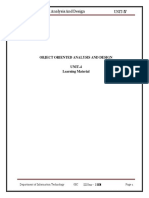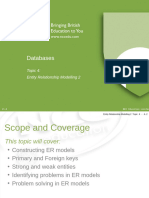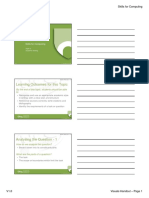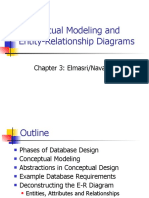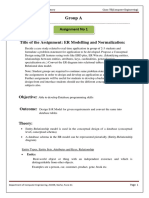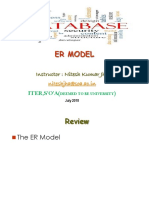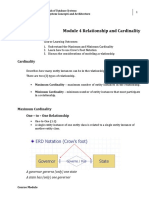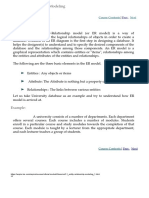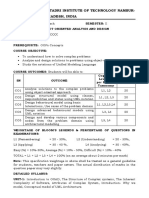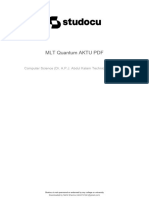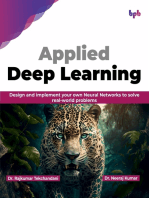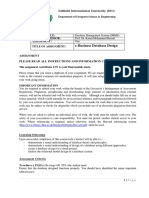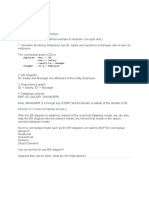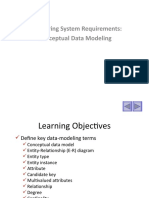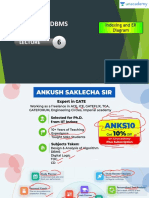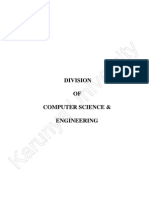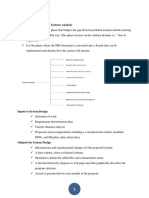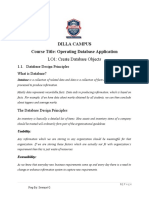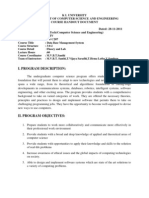Databases: Topic 3: Entity Relationship Modelling 1
Databases: Topic 3: Entity Relationship Modelling 1
Uploaded by
Online MoneyCopyright:
Available Formats
Databases: Topic 3: Entity Relationship Modelling 1
Databases: Topic 3: Entity Relationship Modelling 1
Uploaded by
Online MoneyOriginal Description:
Original Title
Copyright
Available Formats
Share this document
Did you find this document useful?
Is this content inappropriate?
Copyright:
Available Formats
Databases: Topic 3: Entity Relationship Modelling 1
Databases: Topic 3: Entity Relationship Modelling 1
Uploaded by
Online MoneyCopyright:
Available Formats
Databases
Topic 3:
Entity Relationship Modelling 1
V1.0 NCC Education Limited
Entity Relationship Modelling 1 Topic 3 - 3.2
Scope and Coverage
This topic will cover:
Entity Relationship Modelling
Types of Notation
Basic concepts
Entities
Relationships
Attributes
Identifying Entities
V1.0 NCC Education Limited
Entity Relationship Modelling 1 Topic 3 - 3.3
Learning Outcomes
By the end of this topic, students will be able to:
Understand the goal of ER modelling
Recognise different types of notation
Understand the concepts of an entity type,
relationships and attributes
Begin to develop an approach to identifying entities
V1.0 NCC Education Limited
Entity Relationship Modelling 1 Topic 3 - 3.4
The Goal of Entity Relationship
Modelling
To produce a model of data and data use that is
non-technical and free of ambiguities
V1.0 NCC Education Limited
Entity Relationship Modelling 1 Topic 3 - 3.5
Notations 1 - UML Module
Attributes:
Module Code(PK)
Module Name
1
0...*
Student Attributes:
on Module Code (FK)
Module Student No (FK)
0...*
1
Attributes:
Student Student No(PK)
Student Name
V1.0 NCC Education Limited
Entity Relationship Modelling 1 Topic 3 - 3.6
Notations 2 - Attributes:
Module Module Code(PK)
CROWS FEET Module Name
Attributes:
Student on
Module Code(PK)(FK)
Module
Student No (PK) (FK)
Attributes:
Student Student No(PK)
Student Name
V1.0 NCC Education Limited
Entity Relationship Modelling 1 Topic 3 - 3.7
Notations 3 -
CHEN Module Module Code
Takes
M
Student No
Student
V1.0 NCC Education Limited
Entity Relationship Modelling 1 Topic 3 - 3.8
Entity Type
A group of objects, people, types, concepts or other
items that have the same set of properties (known
as attributes).
Must be of interest to whoever is building the new
information system.
V1.0 NCC Education Limited
Entity Relationship Modelling 1 Topic 3 - 3.9
Entity Occurrence
A unique instance of an entity
V1.0 NCC Education Limited
Entity Relationship Modelling 1 Topic 3 - 3.10
Activity
Identify entity types that might exist in a LIBRARY
SYSTEM.
Can you also think of some entity occurrences?
V1.0 NCC Education Limited
Entity Relationship Modelling 1 Topic 3 - 3.11
Library System ER
Author
Book
Borrower
Subject
Loan
V1.0 NCC Education Limited
Entity Relationship Modelling 1 Topic 3 - 3.12
Occurrences of Entity Types in a
Library System
Book:
Lord of the Rings
Introduction to Databases
How to Win friends and Influence people
Subject:
History
Fiction
V1.0 NCC Education Limited
Entity Relationship Modelling 1 Topic 3 - 3.13
Diagrammatic Representation of
Entity Types
Each entity type is shown as a rectangle labeled with the name of the entity,
which is normally a singular noun.
In UML, the name of an entity should begin with an upper case letter.
Book
V1.0 NCC Education Limited
Entity Relationship Modelling 1 Topic 3 - 3.14
Relationship Types
The meaningful associations between entity types
V1.0 NCC Education Limited
Entity Relationship Modelling 1 Topic 3 - 3.15
Relationship Occurrence
The concrete instance of a relationship type
V1.0 NCC Education Limited
Entity Relationship Modelling 1 Topic 3 - 3.16
Activity - What Relationships Exist
between these Entities? - 1
Book Author
Borrower
Subject Loan
V1.0 NCC Education Limited
Entity Relationship Modelling 1 Topic 3 - 3.17
Activity - What Relationships Exist
between these Entities? - 2
Author
Book
Borrower
Subject
Loan
V1.0 NCC Education Limited
Entity Relationship Modelling 1 Topic 3 - 3.18
Organising it Better
Author
Book Loan Borrower
Subject
V1.0 NCC Education Limited
Entity Relationship Modelling 1 Topic 3 - 3.19
Relationship Names
Author
Writes
Taken out on Takes out
Book Loan Borrower
Classifies
Subject
V1.0 NCC Education Limited
Entity Relationship Modelling 1 Topic 3 - 3.20
Multiplicity - 1
Number or range of possible occurrences of an
entity type in relation to another entity type
V1.0 NCC Education Limited
Entity Relationship Modelling 1 Topic 3 - 3.21
Multiplicity - 2
Author
Writes
Book Loan Borrower
Taken out on Takes out
Classifies
Subject
A Book is Classified by ONE Subject. But ONE
Subject could classify many Books.
V1.0 NCC Education Limited
Entity Relationship Modelling 1 Topic 3 - 3.22
Multiplicity - 3
Book
0..*
Classifies
Subject
A Book is Classified by ONE subject. But ONE
Subject could classify none or many Books.
V1.0 NCC Education Limited
Entity Relationship Modelling 1 Topic 3 - 3.23
Author
Multiplicity - 4 1..*
Writes
1..*
Book
0..*
Classifies
1
Subject
A Book is Written by ONE or more Authors. An
Author writes one or more Books.
V1.0 NCC Education Limited
Entity Relationship Modelling 1 Topic 3 - 3.24
Self-Study
Author
Writes
Taken out on Takes out
Book Loan Borrower
Classifies
Subject
A Book is Classified by ONE subject. But ONE
Subject could classify many Books.
V1.0 NCC Education Limited
Entity Relationship Modelling 1 Topic 3 - 3.25
Attributes - 1
A property of an entity type.
V1.0 NCC Education Limited
Entity Relationship Modelling 1 Topic 3 - 3.26
Attributes - 2
Attribute Domain
Simple Attribute
Composite Attribute
Single-valued attribute
Multi-valued attribute
V1.0 NCC Education Limited
Entity Relationship Modelling 1 Topic 3 - 3.27
Activity
What are the attributes for the entities we identified
as part of the library system?:
Book
Author
Borrower
Lon
V1.0 NCC Education Limited
Entity Relationship Modelling 1 Topic 3 - 3.28
Identifying Entities - 1
Look for nouns.
Example:
A student record system is used to allocate
students to modules. Each module is part of a
course. Each module has one or more
assessments attached to it.
V1.0 NCC Education Limited
Entity Relationship Modelling 1 Topic 3 - 3.29
Identifying Entities - 2
Look for nouns.
Example:
A student record system is used to allocate
students to modules. Each module is part of a
course. Each module has one or more
assessments attached to it.
V1.0 NCC Education Limited
Entity Relationship Modelling 1 Topic 3 - 3.30
Identifying Entities - 3
This can also be done with a bottom up approach
using normalisation which we will look at later.
For now we are using a top-down approach.
There will be an exercise as part of the self-study.
V1.0 NCC Education Limited
Entity Relationship Modelling 1 Topic 3 - 3.31
Learning Outcomes Revisited
Have we met them?
By the end of this topic, students will be able to:
Understand the goal of ER Modelling
Recognise different types of notation
Understand the concepts of an entity type,
relationships and attributes
Begin to develop an approach to identifying entities
V1.0 NCC Education Limited
Entity Relationship Modelling 1 Topic 3 - 3.32
References
Connolly, T. & Begg, C. (2004). Database Systems:
A Practical Approach to Design, Implementation,
and Management, 4th Edition. Addison Wesley.
Chapter 11.
V1.0 NCC Education Limited
Entity Relationship Modelling 1 Topic 3 - 3.33
Topic 3 Entity Relationship Modelling 1
Any Questions?
V1.0 NCC Education Limited
You might also like
- Fundamentals of Database Management Systems 2nd Edition Gillenson Solutions ManualDocument12 pagesFundamentals of Database Management Systems 2nd Edition Gillenson Solutions ManualEricJacksonfdbpm100% (15)
- TOPIC 4 ER ModelingDocument37 pagesTOPIC 4 ER ModelingNowlghtNo ratings yet
- Object Oriented Analysis and Design UNIT-4 Learning MaterialDocument33 pagesObject Oriented Analysis and Design UNIT-4 Learning Materialsoumya moturiNo ratings yet
- Info Sys 222 NotesDocument53 pagesInfo Sys 222 Notes정예지No ratings yet
- DB Topic 4Document32 pagesDB Topic 4Edward AllenNo ratings yet
- DB Topic 4 - Entity Relationhip Modelling 2Document41 pagesDB Topic 4 - Entity Relationhip Modelling 2mushekwa akabondoNo ratings yet
- Screenshot 2023-11-04 at 2.20.18 PMDocument32 pagesScreenshot 2023-11-04 at 2.20.18 PMtheintshwesin2004No ratings yet
- SFC Topic 3Document13 pagesSFC Topic 3FatsaniNo ratings yet
- ERMODELchp 1Document57 pagesERMODELchp 1Anshuman021No ratings yet
- DB Topic 4Document32 pagesDB Topic 4Online MoneyNo ratings yet
- Topic 8. Semantic Data Modeling: Conceptual ModelDocument30 pagesTopic 8. Semantic Data Modeling: Conceptual Modelданил мартыненковNo ratings yet
- Unit 2. Entity Relationship Model and Relational ModelDocument28 pagesUnit 2. Entity Relationship Model and Relational ModelcgandulduqueNo ratings yet
- Conceptual Modeling and Entity-Relationship Diagrams: Chapter 3: Elmasri/NavatheDocument52 pagesConceptual Modeling and Entity-Relationship Diagrams: Chapter 3: Elmasri/NavatheHARDIK PANPALIYANo ratings yet
- Notes Oopm Unit 2Document33 pagesNotes Oopm Unit 2elishasupreme30No ratings yet
- Molecules Unit PlanDocument5 pagesMolecules Unit PlanMelorie MutiaNo ratings yet
- 03) Data Modeling With ERDDocument29 pages03) Data Modeling With ERDAbhay SharmaNo ratings yet
- Unit 1adtnotesDocument98 pagesUnit 1adtnotesJobi VijayNo ratings yet
- Dbms Exp 1 TheoryDocument14 pagesDbms Exp 1 Theoryadijadhav104No ratings yet
- ER Model (Database Management)Document19 pagesER Model (Database Management)anon_453834053No ratings yet
- Module 4 - Relationship and Cardinality PDFDocument7 pagesModule 4 - Relationship and Cardinality PDFJacob Satorious ExcaliburNo ratings yet
- Jobsheet ERD-eng PDFDocument7 pagesJobsheet ERD-eng PDFRizki Irfan MaulanaNo ratings yet
- Tutorial Week3 Solutions INFO20003Document10 pagesTutorial Week3 Solutions INFO20003gongyuerkellyNo ratings yet
- Dbms 1Document12 pagesDbms 1227r1a0519No ratings yet
- INTRODUCTION OF INFO SYSTEM InsamDocument76 pagesINTRODUCTION OF INFO SYSTEM InsamEkobe blaiseNo ratings yet
- MC5305-OOAD SyllabusDocument152 pagesMC5305-OOAD SyllabusLakshmiNo ratings yet
- User Context Aware Delivery of E-Learning Material: Approach and ArchitectureDocument9 pagesUser Context Aware Delivery of E-Learning Material: Approach and ArchitecturePriya MahajanNo ratings yet
- 2019 - Multi-Label Image Classification by Feature Attention NetworkDocument9 pages2019 - Multi-Label Image Classification by Feature Attention NetworkMinh Hải NgôNo ratings yet
- Object Counting YoloDocument7 pagesObject Counting YoloHi ManshuNo ratings yet
- DB Topic 5Document29 pagesDB Topic 5Online MoneyNo ratings yet
- Contextualized CG For LS 6.2 Empowerment Technology - VettedDocument23 pagesContextualized CG For LS 6.2 Empowerment Technology - Vettedkris villocinoNo ratings yet
- Clase 5 - WomenForceITDocument24 pagesClase 5 - WomenForceITMau HelopNo ratings yet
- Lecture 5 ER ModelingDocument21 pagesLecture 5 ER ModelingMalik Adnan JaleelNo ratings yet
- Co1 Session4Document38 pagesCo1 Session4Jayavarapu Karthik JNo ratings yet
- Dbms Report2-2Document30 pagesDbms Report2-2Rekha HNo ratings yet
- 611a39231265660010ce8df9-1629109230-Module 1 - Lesson 1 Part 2Document9 pages611a39231265660010ce8df9-1629109230-Module 1 - Lesson 1 Part 2Aldvin Jan AlcasidNo ratings yet
- Subject: Object Oriented Subject Code: CS E61: Analysis and DesignDocument26 pagesSubject: Object Oriented Subject Code: CS E61: Analysis and DesignSasiDharNo ratings yet
- Oose NotesDocument46 pagesOose NotesAbhishek Singh 2080No ratings yet
- Lab 2 DBS - 082722Document4 pagesLab 2 DBS - 082722umerabid253No ratings yet
- Entity/Relationship Modelling: Database Systems Lecture # 5 Mr. Jahanzaib NiaziDocument45 pagesEntity/Relationship Modelling: Database Systems Lecture # 5 Mr. Jahanzaib NiaziIrfan Muddassir0% (1)
- Chapter 3-1Document20 pagesChapter 3-1bmulat87No ratings yet
- Object Oriented Analysis and Design UNIT-4 Learning MaterialDocument33 pagesObject Oriented Analysis and Design UNIT-4 Learning Materialsoumya moturiNo ratings yet
- Lab Manual File: Course CoordinatorDocument49 pagesLab Manual File: Course CoordinatorAkshat TarateNo ratings yet
- Example:: Course ContentsDocument72 pagesExample:: Course ContentsKailai NathanNo ratings yet
- OOAD Model Paper 20-03-2023Document6 pagesOOAD Model Paper 20-03-2023balakailasa100% (3)
- CHAP03 Modeling Data in The OrganizationDocument42 pagesCHAP03 Modeling Data in The OrganizationJosef AdalimNo ratings yet
- Oops 4Document76 pagesOops 4Naveen NagalingamNo ratings yet
- Course Code: CS353: Course Title: Software Requirment EngineeringDocument38 pagesCourse Code: CS353: Course Title: Software Requirment EngineeringTosiq AhmedNo ratings yet
- Summary Chapter 2 - Data ModelsDocument8 pagesSummary Chapter 2 - Data ModelsMUHAMMAD AKMAL MOHD ZAHARNo ratings yet
- Summary Chapter 4n5 - ERDDocument17 pagesSummary Chapter 4n5 - ERDSiti Nur HanisNo ratings yet
- Se Lec8 9Document47 pagesSe Lec8 9mirzadaniyalkhan24No ratings yet
- Edu 589-Capstone Project-Option A Lesson Plan-C ThroenerDocument25 pagesEdu 589-Capstone Project-Option A Lesson Plan-C Throenerapi-291012298No ratings yet
- Unit 20 - Assignment 1 FrontsheetDocument14 pagesUnit 20 - Assignment 1 FrontsheetTran Quang Hiep (FGW HN)No ratings yet
- Agents and Objects: An Empirical Study On The Design and Implementation of Mass"Document78 pagesAgents and Objects: An Empirical Study On The Design and Implementation of Mass"KamusEJNo ratings yet
- Machine Learning 1Document160 pagesMachine Learning 1KumarNo ratings yet
- MCS-032 Solved AssignmentDocument35 pagesMCS-032 Solved AssignmentrajlagwalNo ratings yet
- Data Modeling Using The Entity-Relationship ModelDocument28 pagesData Modeling Using The Entity-Relationship ModelVineet Gupta100% (1)
- Object Oriented Modeling and Design With UML: Text BooksDocument40 pagesObject Oriented Modeling and Design With UML: Text BooksAdithya BhatNo ratings yet
- Applied Deep Learning: Design and implement your own Neural Networks to solve real-world problems (English Edition)From EverandApplied Deep Learning: Design and implement your own Neural Networks to solve real-world problems (English Edition)No ratings yet
- DB Topic 10Document30 pagesDB Topic 10Online MoneyNo ratings yet
- Databases: Topic 9: Database DesignDocument27 pagesDatabases: Topic 9: Database DesignOnline MoneyNo ratings yet
- DB Topic 4Document32 pagesDB Topic 4Online MoneyNo ratings yet
- DB Topic 5Document29 pagesDB Topic 5Online MoneyNo ratings yet
- DB Topic 7Document30 pagesDB Topic 7Online MoneyNo ratings yet
- DB Topic 11Document30 pagesDB Topic 11Online MoneyNo ratings yet
- DB Topic 2Document29 pagesDB Topic 2Online MoneyNo ratings yet
- ER Diagrams (Concluded), Schema Refinement, and NormalizationDocument39 pagesER Diagrams (Concluded), Schema Refinement, and NormalizationrajendragNo ratings yet
- Relationship Diagram (ER Diagram)Document33 pagesRelationship Diagram (ER Diagram)JESHUA MARK BAYNo ratings yet
- Database Management - Session 3Document54 pagesDatabase Management - Session 3Jinen MirjeNo ratings yet
- Assignment DBMS DIUDocument7 pagesAssignment DBMS DIUMd. Jabed HossainNo ratings yet
- DBMS Case StudyDocument10 pagesDBMS Case StudyRahul SinghNo ratings yet
- CS CurriculumDocument302 pagesCS CurriculumEndash HaileNo ratings yet
- Complete Query - User Requirement and System RequirementDocument39 pagesComplete Query - User Requirement and System RequirementSadip BhattaraiNo ratings yet
- Database Project Documentation by Tole Fikadu Aga, 2022Document13 pagesDatabase Project Documentation by Tole Fikadu Aga, 2022TolichoNo ratings yet
- SRS On OSMSDocument93 pagesSRS On OSMSHalimaNo ratings yet
- Assignment Cover Sheet - Individual & GroupDocument12 pagesAssignment Cover Sheet - Individual & Groupigor ritongaNo ratings yet
- (Database Management Systems) : Biag, Marvin, B. BSIT - 202 September 6 2019Document7 pages(Database Management Systems) : Biag, Marvin, B. BSIT - 202 September 6 2019Marcos JeremyNo ratings yet
- Structuring System Requirements: Conceptual Data ModelingDocument25 pagesStructuring System Requirements: Conceptual Data Modelingnurol03No ratings yet
- Sankalp For DBMS - Indexing and ER DiagramDocument52 pagesSankalp For DBMS - Indexing and ER DiagramDigambar DiwakarNo ratings yet
- Prashath DDD AssignmentDocument40 pagesPrashath DDD AssignmentJAANUJAN RaviNo ratings yet
- المشروعDocument6 pagesالمشروعTaha Al-husnNo ratings yet
- DFo 2 3 PracticeDocument2 pagesDFo 2 3 PracticeNABILA sajaNo ratings yet
- CseDocument166 pagesCseSalman ShaikhNo ratings yet
- Chapter 4 AISDocument7 pagesChapter 4 AISmohammedNo ratings yet
- Aplikasi Web Layanan Warga (1) - CompressedDocument28 pagesAplikasi Web Layanan Warga (1) - CompressedonlymeharisNo ratings yet
- Bca Solved Assignment BCSL 034 Dbms Lab PDFDocument10 pagesBca Solved Assignment BCSL 034 Dbms Lab PDFbinod shresthaNo ratings yet
- 1 SRS (Email Spam Detection) - Introduction:: 1.1.1 PurposeDocument10 pages1 SRS (Email Spam Detection) - Introduction:: 1.1.1 Purposeudyadav430No ratings yet
- DFo 1 1Document14 pagesDFo 1 1Dwi Wahyu PrabowoNo ratings yet
- Real Time SystemDocument9 pagesReal Time SystemJC CerezoNo ratings yet
- Sample Document BSISDocument109 pagesSample Document BSISKyle Isabel DungcaNo ratings yet
- Fall 2022 - CS403 - 1Document6 pagesFall 2022 - CS403 - 1andleebrazzaq059No ratings yet
- Operate Database Application LO1Document9 pagesOperate Database Application LO1Sewunet GetachewNo ratings yet
- Online Shopping Portal: Project Report OnDocument103 pagesOnline Shopping Portal: Project Report OnPratik DashNo ratings yet
- CSC207Document14 pagesCSC207Chunduru Devi AnushaNo ratings yet
- DMS MicroprojectDocument10 pagesDMS Microprojectrobinheart00No ratings yet


